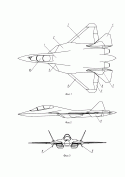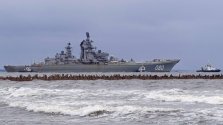The first footage of the production of one of the most popular Russian FPV drones "VT-40", the video was shot by journalist Alexey Egorov. The Rubicon Unmanned Technology Center is now actively using these drones, among others. The "VT-40" drone was developed in 2022 by the "Russian Drone" company, and since 2023 they have been actively used by the "Sudoplatova - Judgment Day" project. The "VT-40" drone is named after war correspondent Vladlen Tatarsky. As can be seen from the video, the production is quite large-scale, now up to 1000 drones can be assembled per knock by order of the Ministry of Defense. Several types of "VT-40" drones are currently being produced. The FPV drone's configuration allows it to work with various types of ammunition weighing from 1.3 to 4.5 kg at a distance of 7 to 30 km, when using a repeater. Drones can be equipped with a night vision camera and have control via fiber-optic cable. FPV drones "VT-40" are considered inexpensive, the price is about 50 thousand rubles or $ 500.
You are using an out of date browser. It may not display this or other websites correctly.
You should upgrade or use an alternative browser.
You should upgrade or use an alternative browser.
Russian Military News, Reports, Data, etc.
- Thread starter tphuang
- Start date
more exchanges we are not aware of yet.
I'm more interested on the nature of the deal tho. Especially with many "OSINT" out there suggest Russia backstabbing Iran for not delivering. But as seen for Shahed and UAV deals. It was fully transactional in nature where Russia Pay Iran in hard currency for the Tech transfers and other stuff.
For Su-35 deal, Iran just hasnt pay, thus no deliveries.
Yes that sounds likely. Thus Algeria gets aircraft before Iran.
Had Iran sent the money to get combat aircraft no doubt they would get some this year.
But Iran has been making deals in Russia thanks to the free trade agreement they have with the EAEU. So I am sure the funding will be there eventually.
Had Iran sent the money to get combat aircraft no doubt they would get some this year.
But Iran has been making deals in Russia thanks to the free trade agreement they have with the EAEU. So I am sure the funding will be there eventually.
Rare footage of the Il-96-300PU aircraft of Russian President Vladimir Putin being escorted by F-35 Lightning II fighters of the US Air Force during the Il-96 flight from Alaska to Russia. The Il-96 aircraft took off from the American military base Elmendorf-Richardson in Anchorage, where the US and Russia held talks on the situation with Ukraine. Also at the end of the video, the flight of the American strategic bomber B-2 Spirit, accompanied by F-35 Lightning II fighters, is shown over the air base in Alaska, during the meeting there between Presidents Vladimir Putin and Donald Trump. The presidents pass by American F-22 Raptor fighters.
Lethe
Captain
Continuing discussion from the US Military thread in a more appropriate venue.
It may have been desirable to slow the rate of new orders for a few years as the industrial base became saturated, akin to the debates in the United States about the merits of creating an ever-larger submarine production backlog by continuing to procure new boats at rates faster than they are being delivered, but I think the slowdown in procurement has gone on too long now for that to be the full story. Budgetary reallocations arising as a consequence of the conflict in Ukraine are a plausible explanation for why we haven't seen more nuclear submarines laid down in recent years. As you say, the remaining boats from the late Cold War period are not getting any younger, so there is no obvious service-level explanation for why demand would have slackened either. I think a reasonable long-term objective for the Russian Navy and SIB would be lay down, launch and deliver one nuclear submarine per year in order to maintain an inventory of ~30-35 nuclear submarines of all types: SSNs, SSGNs, SSBNs and special mission boats.
We are informed that the potential for submarine quieting is fundamentally constrained by the hull diameter of the submarine. A smaller, less expensive submarine that nonetheless employs first-rate quieting measures therefore implies a relatively short and fat hull form, probably shorter than is hydrodynamically optimal. One route to achieving such a submarine, therefore, is to reduce its speed, akin to the American "Fat Albert" Fast Attack Submarine design, with a notional top speed of 27-knots, that was briefly explored in the late 1970s as an alternative or complement to Rickover's preferred SSN-688 design.
Those US sub construction numbers with two shipyards are just pathetic. 1.5 subs a year on average. The Russians with a single shipyard are putting one SSGN and one SSBN into the water each year.
Submarine production has indeed been a relative bright spot for the Russian Navy, but also potentially a transitory one. The current impressive launch/delivery cadence reflects boats laid down throughout the 2009-2017 period. Since that time, relatively few new nuclear boats have been laid down: two 885Ms and two 955As in the last eight years, down from six 885Ms and five 955As in the nine years preceding. That will soon translate to a reduction in deliveries. It's not clear to me what is going on with the 09851 Poseidon boats, but in any case it does not materially change the relative balance between the two periods. Given the cascading consequences of the conflict in Ukraine for budget priorities, it remains to be seen how committed Russia is to its ongoing submarine renaissance.
The Russians will be building at least a dozen each of the Borei and Yasen. So they will lay down two more Borei and three more Yasen.
There is talk of four Poseidon drone carrier submarines.
Putin also announced the Lada diesel submarines would become serial built boats. So there will be more orders than the current four.
The question is about the Husky and the other next generation submarine projects like Arcturus.
The Russian Navy wants the Husky to be a small nuclear attack submarine to replace the Victor III but the design bureaus claim such a submarine won't have the required level of stealth to be survivable.
I'm sure there will be more boats, I'm not suggesting that Russia is about to abandon its nuclear submarine programs, just that we can't assume that the fairly impressive delivery cadence we've seen in recent years will actually be maintained going forward. Indeed we can be confident that, at least for a period beginning late 2020s, it won't be maintained. Just where the longer-term trends will settle remains to be seen.
It depends on if the Husky is indeed a small boat and the Russians mass produce it or not.
Right now the Russians aren't producing enough submarines to replace their still in service old attack subs let alone have the numbers they had in the Cold War.
A smaller boat could be built outside Sevmash. At Admiralty Shipyards and Krasnoye Sormovo for example.
It may have been desirable to slow the rate of new orders for a few years as the industrial base became saturated, akin to the debates in the United States about the merits of creating an ever-larger submarine production backlog by continuing to procure new boats at rates faster than they are being delivered, but I think the slowdown in procurement has gone on too long now for that to be the full story. Budgetary reallocations arising as a consequence of the conflict in Ukraine are a plausible explanation for why we haven't seen more nuclear submarines laid down in recent years. As you say, the remaining boats from the late Cold War period are not getting any younger, so there is no obvious service-level explanation for why demand would have slackened either. I think a reasonable long-term objective for the Russian Navy and SIB would be lay down, launch and deliver one nuclear submarine per year in order to maintain an inventory of ~30-35 nuclear submarines of all types: SSNs, SSGNs, SSBNs and special mission boats.
We are informed that the potential for submarine quieting is fundamentally constrained by the hull diameter of the submarine. A smaller, less expensive submarine that nonetheless employs first-rate quieting measures therefore implies a relatively short and fat hull form, probably shorter than is hydrodynamically optimal. One route to achieving such a submarine, therefore, is to reduce its speed, akin to the American "Fat Albert" Fast Attack Submarine design, with a notional top speed of 27-knots, that was briefly explored in the late 1970s as an alternative or complement to Rickover's preferred SSN-688 design.
Last edited:
There is no way you will produce more tanks or artillery for Ukraine by cutting orders at Sevmash for nuclear submarines. So that saves nothing.
More likely is that for example they are using staff from Sevmash to upgrade the Admiral Nakhimov, or that the capacity to build submarine nuclear reactors is being tied on nuclear icebreaker reactor construction.
I have heard rumours of people moving from Sevmash (SSNs) to the Baltic Shipyard (nuclear icebreakers) due to higher salaries so IMHO that is a way more likely event.
The Poseidon carriers are also on the pipeline and these are less visible projects. There are no two ways about it.
In other words the War in Ukraine should have had little impact, but the boom in nuclear icebreaker orders is likely having a negative impact in nuclear submarine construction.
More likely is that for example they are using staff from Sevmash to upgrade the Admiral Nakhimov, or that the capacity to build submarine nuclear reactors is being tied on nuclear icebreaker reactor construction.
I have heard rumours of people moving from Sevmash (SSNs) to the Baltic Shipyard (nuclear icebreakers) due to higher salaries so IMHO that is a way more likely event.
The Poseidon carriers are also on the pipeline and these are less visible projects. There are no two ways about it.
In other words the War in Ukraine should have had little impact, but the boom in nuclear icebreaker orders is likely having a negative impact in nuclear submarine construction.
Last edited:


